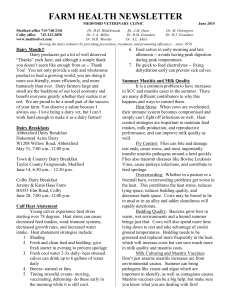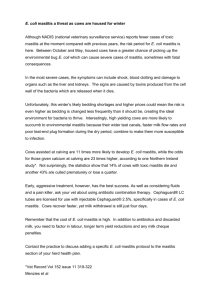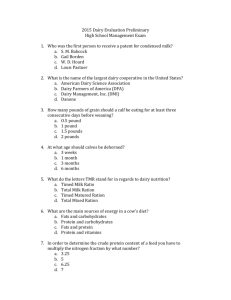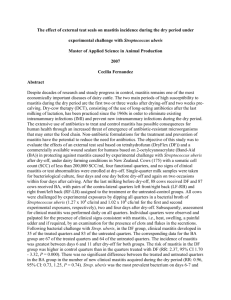Control of bovine sub-clinical mastitis by using herbal extract during
advertisement
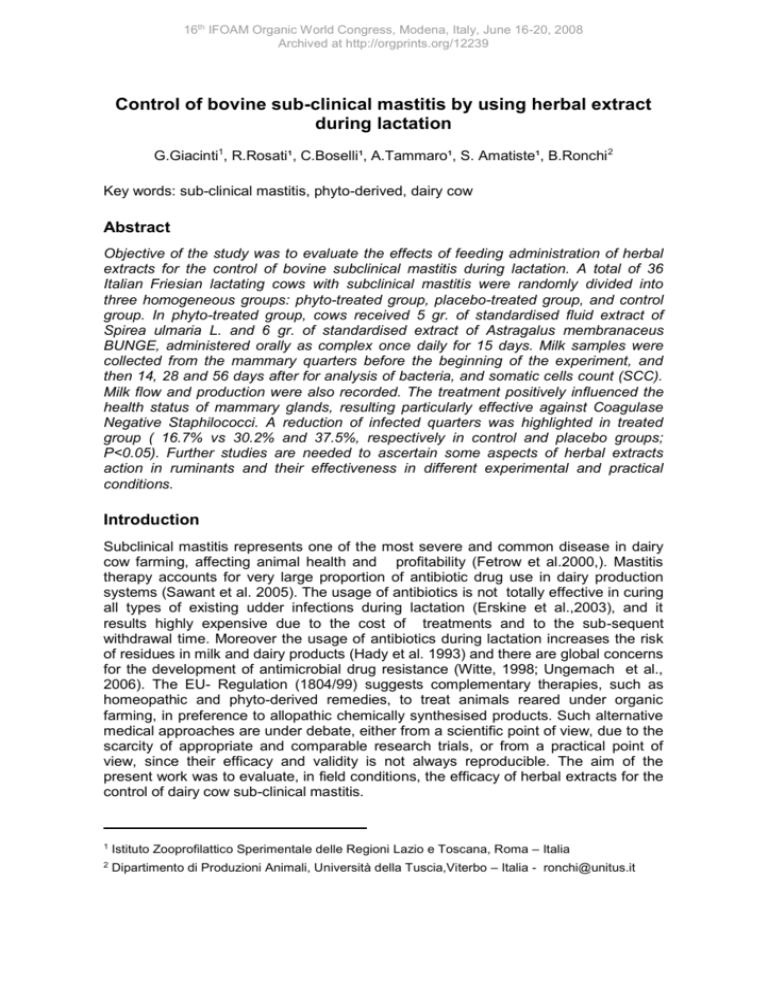
16th IFOAM Organic World Congress, Modena, Italy, June 16-20, 2008 Archived at http://orgprints.org/12239 Control of bovine sub-clinical mastitis by using herbal extract during lactation G.Giacinti1, R.Rosati¹, C.Boselli¹, A.Tammaro¹, S. Amatiste¹, B.Ronchi 2 Key words: sub-clinical mastitis, phyto-derived, dairy cow Abstract Objective of the study was to evaluate the effects of feeding administration of herbal extracts for the control of bovine subclinical mastitis during lactation. A total of 36 Italian Friesian lactating cows with subclinical mastitis were randomly divided into three homogeneous groups: phyto-treated group, placebo-treated group, and control group. In phyto-treated group, cows received 5 gr. of standardised fluid extract of Spirea ulmaria L. and 6 gr. of standardised extract of Astragalus membranaceus BUNGE, administered orally as complex once daily for 15 days. Milk samples were collected from the mammary quarters before the beginning of the experiment, and then 14, 28 and 56 days after for analysis of bacteria, and somatic cells count (SCC). Milk flow and production were also recorded. The treatment positively influenced the health status of mammary glands, resulting particularly effective against Coagulase Negative Staphilococci. A reduction of infected quarters was highlighted in treated group ( 16.7% vs 30.2% and 37.5%, respectively in control and placebo groups; P<0.05). Further studies are needed to ascertain some aspects of herbal extracts action in ruminants and their effectiveness in different experimental and practical conditions. Introduction Subclinical mastitis represents one of the most severe and common disease in dairy cow farming, affecting animal health and profitability (Fetrow et al.2000,). Mastitis therapy accounts for very large proportion of antibiotic drug use in dairy production systems (Sawant et al. 2005). The usage of antibiotics is not totally effective in curing all types of existing udder infections during lactation (Erskine et al.,2003), and it results highly expensive due to the cost of treatments and to the sub-sequent withdrawal time. Moreover the usage of antibiotics during lactation increases the risk of residues in milk and dairy products (Hady et al. 1993) and there are global concerns for the development of antimicrobial drug resistance (Witte, 1998; Ungemach et al., 2006). The EU- Regulation (1804/99) suggests complementary therapies, such as homeopathic and phyto-derived remedies, to treat animals reared under organic farming, in preference to allopathic chemically synthesised products. Such alternative medical approaches are under debate, either from a scientific point of view, due to the scarcity of appropriate and comparable research trials, or from a practical point of view, since their efficacy and validity is not always reproducible. The aim of the present work was to evaluate, in field conditions, the efficacy of herbal extracts for the control of dairy cow sub-clinical mastitis. 1 Istituto Zooprofilattico Sperimentale delle Regioni Lazio e Toscana, Roma – Italia 2 Dipartimento di Produzioni Animali, Università della Tuscia,Viterbo – Italia - ronchi@unitus.it 16th IFOAM Organic World Congress, Modena, Italy, June 16-20, 2008 Archived at http://orgprints.org/12239 Material and methods The study was carried out in a commercial dairy cow farm located in the province of Roma. For a preliminary check of mammary glands status, individual quarter milk samples from 80 Italian Frisian lactating cows were collected 15 and 7 days before the beginning of the experiment, to determine somatic cell count (SCC). Thirty-six cows with two consecutive SCC over 200.000 cell/ml in at least one quarter and no evidence of clinical mastitis were considered affected by sub-clinical mastitis (Bradley and Green, 2005) and selected for the trial. Three groups of twelve cows were randomly formed, balanced for days in milk and parity: phyto (PH) (days in milk 177 ± 22, parity 3,7 ± 0,48), placebo (P) (days in milk 161 ± 27, parity 3,5 ± 0,44), and control (C) (days in milk 169 ± 23, parity 3,1 ± 0,46). Cows from PH group received 5 gr. of standardised fluid extract of Spirea ulmaria L. and 6 gr. of standardised extract of Astragalus membranaceus BUNGE (Biorama), administered orally as complex once daily for 15 days. Cows from P group received the same quantity of physiological solution. Herbal extract and physiological solution were given orally using a disposable syringe. For animals treated with herbal extract, a precautionary withdrawal time of 18 days was planned (15 days of trial, and 3 days after). Aseptic milk samples were collected from quarters of each cow during the evening milking at day 1 (beginning of experiment), and then after 14, 28, and 56, according to the International Dairy Federation guidelines. All samples were processed for bacteriological analyses. A portable milkmeter Lactocorder (WMB AG, CH Balgach) was used to record milk production and to measure milk flow. Milks samples (10 µl ) were spread on blood agar (5% defibrinated bovine blood) and Edward’s medium modified plates. The plates were incubated aerobically at 37°C and examined for growth after 24 and 42 h. Mastitis status of milk samples was determined by diagnostic procedures recommended by National Mastitis Council (National Mastitis Council, 1987). Milk samples were analysed for somatic cells content (SCC) by fluoro-opto-metric method with Fossomatic 5000 (Foss Electric, HillerØd, Denmark). Data analysis was performed by using Chi-Square and Student-t statistical significance tests (MedCalc, 2006). Results were considered statistically significant when p<0.05. Results are presented as mean ± S.E.M. Results During the entire period, none of the cows showed clinical signs of mastitis. The most prevalent pathogens were environmental streptococci,mainly Streptococcus uberis and Streptococcus dysgalactiae, isolated in 109 quarters (55,6%). Coagulase negative staphylococci (CNS) were isolated in 76 quarters (38,8 %), while Staphylococcus aureus was isolated only in 6 quarters (3,1%). The prevalence of Gram negative bacteria was very low (5 quarters, 2,5 %). At the beginning of trial, 16 quarters (32.7 %) resulted infected in PH group, 20 quarters (41,7 %) in P group, and 17 quarters (35,4 %) in C group. In PH and P groups two cows showed infection by S. aureus in a single quarter. Percentage of quarters infected resulted quite variable during the trial. The bacteriological status did not differ significantly among groups at day 0, 14, and 28, while a significant (P<0.05) reduction of quarters infected was observed in PH group at the end of the experiment (day 56) (Table 1). 16th IFOAM Organic World Congress, Modena, Italy, June 16-20, 2008 Archived at http://orgprints.org/12239 Tab. 1: Relative percentage of quarters infected during the experiment PH group 32.7 23.1 28.6 16.7(*) Day 0 Day 14 Day 28 Day 56 (*) P<0.05 P group 41.7 36.1 30.6 37.5(*) C group 35.4 25.0 13.9 30.6 Considering single species of intramammary gland pathogens, an average reduction of infections induced by CNS was observed in PH group (figure 1), with lowest values (P<0.05) at third control (day 28). No differences among groups were detected for infection induced by environmental streptococci. Quarters infected by S. aureus, at 28 and 56 days after treatment resulted negative in PH group, while remained positive in P group. Figure 1: relative percentage of quarters infected by CNS during the experiment 70,0% 60,0% 50,0% C N S % 40,0% 30,0% 20,0% 10,0% 0,0% PH group P group C group Day 0 47,1% (8) 53,3% 54,5% Day 14 25% 53,8% 55,6% Day 28 6,3%* 27,3%* 40%* Day 56 25% 27,3% 63,6% (*) P<0.05 The phyto-derived treatment induced in PH group a progressive, but not significant, reduction of SCC in the quarters infected (table 3). A variable trend of SCC was observed in P, and C groups. Tab. 3: Mean values ± E.S. of SCC in infected quarters during the experiment. Day 0 Day 14 Day 28 Day 56 PH group P group C group (SCCx1.000/ml) (SCCx1.000/ml) (SCCx1.000/ml) 2.030 ± 1.159 430 ± 131 3.944 ± 2.254 1.185 ± 513 640 ± 415 862 ± 676 482 ± 117 2.038 ± 1.483 1.837 ± 1.495 426 ± 198 942 ± 468 1.567 ± 1.484 Regarding milk production and milk flow parameters, better results were observed in PH group, although non significant. In detail, at the end of trial the milk yield resulted higher in PH group (10,730.83 kg,), compared with P group (10,680.82 kg) and C group (10,160.82 kg). The average milk flow during time resulted greater in PH group 16th IFOAM Organic World Congress, Modena, Italy, June 16-20, 2008 Archived at http://orgprints.org/12239 (2,56 ±0.12 kg/min), than in the P group (2,29 ±0.12 kg/min) and C group (2.32 ±0.15 kg/min). Discussion Results obtained from the study indicate beneficial effects of phyto-derived remedies against subclinical mastitis of lactating dairy cows, particularly against forms caused by CNS. Our data are not comparable with results obtained by other authors, due to differences in active compounds chosen for the experiment. The positive effects may be related to the specific anti-inflammatory actions of Spiraea ulmaria L., and immunomodulatory actions of Astragalus membranaceus BUNGE (Campanini, 2004). The scarcity of results against environmental streptococci, highlighted also in previous experiments with intramammary antibiotic therapy (Bramley,1997), is probably due to the presence of chronic unresponsive infections. For a perspective of application in the livestock farming system, potential useful herbal extract need to be properly assessed for quality of production, concentration and use. The process of licence should also evaluate specific withdrawal periods. Conclusion Phytotherapy may represent, together with other complementary therapies, an useful tool to control the incidence and negative effects of subclinical mastitis in lactating dairy cow. Phytotherapy can not substitute the application of good management practices, such as a good health program to enhance animal health and welfare. Further studies are needed to ascertain effectiveness in different experimental and practical conditions. References Bradley A. and Green M. (2005). Use and interpretation of somatic cell count data in dairy cows. In Practice, 27: 310-315. Bramley A.J. (1997). Environmental streptococci: summary and issues. Proc. Symp. On “Udder Health Mgmt.”: 95-103. University of Guelph, Ontario, Canada. Campanini E. 2004. Dizionario di fitoterapia e piante medicinali. Ed. Tecniche Nuove, Milano. Erskine, R.J., S.Wagner and F.J.DeGraves (2003). Mastitis therapy and pharmacology. Vet.Clin.Food Anim. 19,p.109-138 Fetrow J., Stewart S., Eicker S., Farnsworth R., Bey R. (2000). Mastitis: An economic consideration. Proceedings of the National Mastitis Council 3-47. Hady,P.J.,Lloyd,J.W.,Kaneene, J.B.(1993). Antimicrobical use lactating dairy cattle. JAVMA 203:210-220. Sawant A.A., Sordillo L.M., Jayarao B.M. (2005): A survey on antibiotic usage in dairy herds in Pennsylvania. J Dairy Sci, 88:2991-2999. Ungemach F.R., Muller-Bahrdt D., Abraham G. 2006. Guidelines for prudent use of antimicrobials and their implications on antibiotic usage in veterinary medicine. Int. J. Medic. Microb., 296: 33-38. Witte W., 1998. Medical consequences of antibiotic use in agriculture. Science 279, 996-997. www.lactocorder.ch (2007). Web site.

